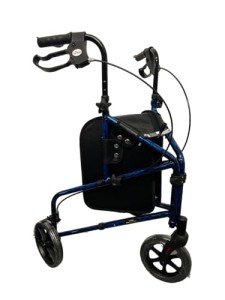outdoor-walker6671
outdoor-walker6671
10 Tell-Tale Symptoms You Must Know To Get A New Rollator Walker
Rollator Walker Safety: A Comprehensive Guide
As individuals age or face mobility obstacles due to health problem or injury, keeping independence frequently becomes a concern. Rollator walkers, offering both support and mobility, have actually become important tools for numerous. Nevertheless, while they offer numerous benefits, making sure safety while utilizing a rollator walker is paramount. This article supplies detailed insights into rollator walker safety, consisting of best practices, common hazards, and vital suggestions for users and caretakers.
Understanding Rollators
A rollator walker is a mobility gadget with wheels that permits individuals to stroll with the support of a frame. Unlike standard walkers, rollators generally feature:

- Three or four wheels for easier maneuverability
- Hand brakes for stopping and controlling speed
- A seat for resting when needed
- Storage compartments for carrying individual items
These features make rollators ideal for both indoor and outdoor use, improving the quality of life for users by providing a sense of self-reliance.
Benefits of Using Rollator Walkers
- Increased Mobility: Rollators can help users in moving safely and easily.
- Support and Stability: With a sturdy frame and brakes, they offer vital support when standing or walking.
- Comfort: Many rollators come with padded seats, permitting users to rest as needed.
- Convenience: Integrated storage solutions can bring necessary items, releasing hands for better balance.
Common Hazards Associated with Rollator Walkers
While rollators can enhance mobility and safety, they can likewise posture dangers. Users must understand prospective risks to minimize accidents:
- Uneven Surfaces: Rollators may tip over if used on uneven or sloped terrain.
- Braking Issues: Failing to engage the brakes adequately can result in falls.
- Excess Weight: Overloading the storage compartments can affect stability.
- Incorrect Use: Not using the rollator as planned can lead to accidents.
- Poor Maintenance: Neglecting routine look at wheels and brakes could result in failure throughout use.
Rollator Walker Safety Tips
To enhance safety while using rollator walkers, think about the following ideas:
1. Proper Fit and Adjustment
- Height Adjustment: Ensure that the deal with height is set to the user’s wrist level when standing upright. A proper fit encourages much better posture and control.
- Seat Height: If the rollator has a seat, guarantee it’s comfortable and available for resting.
2. Routine Maintenance
- Examine Brakes: Make sure hand brakes are functioning appropriately. Change or replace them if necessary.
- Inspect Wheels: Regularly examine wheels for wear and tear, and ensure they spin easily.
- Examine Frame: Check for loose screws or fractures in the frame to guarantee it remains sturdy.
| Upkeep Task | Frequency |
|---|---|
| Brake inspect | Weekly |
| Wheel evaluation | Month-to-month |
| Frame examination | Monthly |
3. Environment Awareness
- Clear Pathways: Keep living areas totally free from mess and obstacles that may present a tripping threat.
- Lighting: Ensure that locations are well-lit to avoid errors, specifically during evening hours.
- Avoid Slippery Floors: Be mindful on damp or waxed floorings, as they can result in falls.
4. Safe Walking Techniques
- Engage Brakes When Stopping: Always engage brakes before sitting or while resting.
- Use Proper Walking Technique: Move slowly and preserve a constant pace, taking steps that match the rollator’s width.
- Balance While Turning: Turn carefully, utilizing the rollator for assistance as required.
5. Look for Assistance
- Involve Caregivers: Encourage relative or caretakers to help in navigating tough terrains or scenarios.
- Make The Most Of Community Resources: Many communities offer mobility training for those utilizing walk-assisting devices.
FAQs about Rollator Walker Safety
Q1: How do I select the right rollator walker?
When choosing a rollator, think about the user’s weight, height, and intended use. It’s also necessary to look for features such as hand brake effectiveness and wheel size, which can affect maneuverability.
Q2: Can I use a rollator walker on unequal surface areas?
While rollators can deal with a variety of surfaces, it is best to prevent high inclines, gravel, or cobblestones, as these can be dangerous. Stick to flat, smooth surfaces whenever possible.
Q3: How can I prevent falls while using a rollator?
Engaging the brakes when sitting, keeping pathways clear, changing your rollator for the appropriate height, and being mindful of your environments can greatly lower the danger of falls.
Q4: Are all rollator walkers the very same?
No, rollators come in various types and sizes, designed for different needs. Some might have additional devices like baskets, while others are lightweight or feature a greater weight capacity.
Q5: Is it safe to carry bags on a rollator?
Always be conscious of the weight limit and distribution of the load. Use the rollator’s designated storage solutions and avoid overwhelming it.
Rollator walkers are invaluable gadgets that enhance mobility and promote independence for users dealing with mobility challenges. Nevertheless, making sure safety while using these devices is essential. By understanding possible hazards, sticking to safe practices, and keeping the walker regularly, users can delight in the benefits of their rollator with reduced risk. Eventually, the goal is to facilitate self-confidence and stability, allowing individuals to browse their world with security and ease. As care providers, relative, and communities focus on safety, they empower users towards a better, more independent lifestyle.
